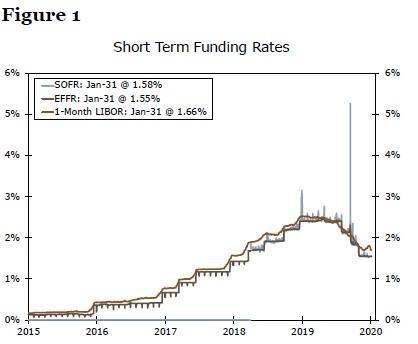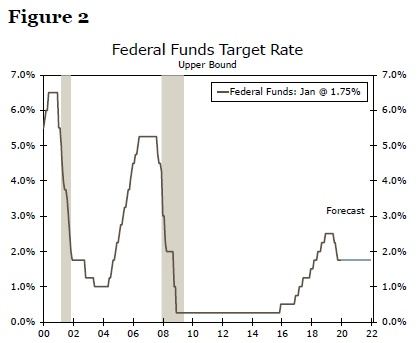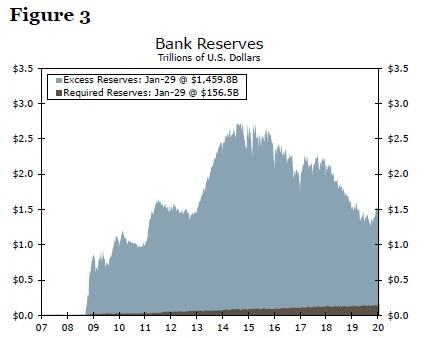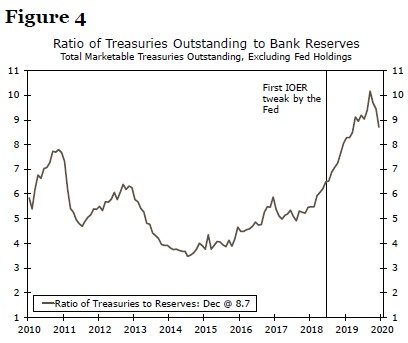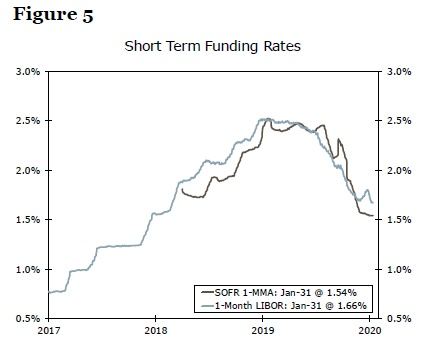What Is SOFR?
LIBOR (London Interbank Offered Rate) has served as a key benchmark interest rate for the past few decades. Although only large banks borrow at the actual LIBOR rate, it is nevertheless familiar to millions of businesses and individuals because their borrowing costs are often tied to LIBOR (typically plus some spread). But, the credibility of LIBOR was undermined, at least in part, by a price-fixing scandal a few years ago, and LIBOR will be phased out as a benchmark borrowing rate, perhaps as early as the beginning of 2022.
Regulators and market participants around the world are in the process of establishing new benchmark interest rates to replace LIBOR. In the United States, this new benchmark rate has been determined and is known as the Secured Overnight Financing Rate (SOFR). Starting sometime in the not-too-distant future, the borrowing costs of non-financial businesses and individuals will likely be tied to SOFR rather than LIBOR.
As shown in Figure 1, LIBOR and SOFR are highly correlated.1 But there are some important differences between the two rates. First, SOFR is based off of actual transaction data, while LIBOR is not. Specifically, the LIBOR setting each day is based on a survey of only 16 global banks. In contrast, SOFR is determined on a continuous basis by the interactions of numerous financial institutions in the Treasury security repo market.2 We will discuss repurchase agreements (i.e., repos) in more detail subsequently.
As its name implies, SOFR is a secured rate. That is, the transactions upon which SOFR is based involve pledging U.S. Treasury securities as collateral in order to borrow cash from other financial institutions. In contrast, LIBOR represents the average rate at which select large banks could fund themselves in the wholesale, unsecured funding market. Another difference is that, as its name implies, SOFR is an overnight rate, whereas LIBOR traditionally has a term component to it (1-month LIBOR, 3-month LIBOR, etc.). Although these technical differences exist between LIBOR and SOFR, the two rates are still highly correlated and both benchmarks have a high degree of co-movement with the effective fed funds rate (EFFR). Consequently, SOFR and LIBOR are similar in that both rates are determined largely by the monetary policy stance of the Federal Reserve.
In that regard, we look for the Federal Open Market Committee (FOMC) to keep its target range for the fed funds rate unchanged through at least the end of 2021 (Figure 2).3 Although we believe that the expansion that has been underway in the U.S. economy since mid-2009 will continue, the real GDP growth rates that we forecast for 2020 (2.1%) and 2021 (2.3%) are not strong enough to induce Fed tightening, in our view. Furthermore, we forecast that rates of consumer price inflation will generally remain benign. With inflation not moving meaningfully above the FOMC's target of 2%, we believe that most committee members will not feel compelled to tighten policy. In short, SOFR should generally remain near its current rate of roughly 1.60% for the foreseeable future.
But as Figure 1 makes apparent, the correlation between LIBOR and SOFR is high but imperfect. Some of the variance between the two rates can simply be explained by the difference in their terms, but there are times when the two rates have diverged significantly, as happened for a few days in September 2019. SOFR spiked nearly 300 bps on September 17, whereas 1-month LIBOR rose just two bps. In short, there are factors other than the monetary policy of the Federal Reserve that can influence SOFR. What are some of these factors, and are there any reasons to expect them to change in the foreseeable future?
To Understand SOFR, You Need to Understand Repo
Since SOFR is based off of repo transactions, it is first important to understand certain dynamics in the repo market. A repurchase agreement is, in short, a way for an institution to borrow or lend cash for a specific period of time, using financial securities as collateral. When it comes to SOFR, the relevant repo transactions specifically focus on borrowing cash overnight collateralized by Treasury securities. Thus, the supply and demand for both loanable cash and Treasury securities can drive movements in Treasury repo markets and thus SOFR.
More than 5,500 depository institutions maintain accounts at the Federal Reserve Banks, where those institution hold their cash reserves. These reserves serve as a key source of loanable cash in the Treasury repo market. As shown in Figure 3, the reserves that the banking system holds at the Federal Reserve mushroomed between late 2008 and 2014 due to the quantitative easing (QE) that the Fed undertook during those years.4 Prior to the financial crisis, banks were reluctant to hold excess reserves because those reserve holdings did not earn interest. But legislation that Congress enacted during the Great Recession gave the Federal Reserve the authority to pay interest on reserves. Furthermore, reserves are an important component of the high quality liquid assets (HQLA) that banks must now hold for regulatory requirements. Consequently, banks willingly hold excess reserves today in sizable quantities.
But the Federal Reserve began unwinding QE in October 2017 by allowing the Treasury securities and MBS that it owns to slowly run off its balance sheet. This shrinkage on the asset side of the Fed's balance sheet must be reflected in a commensurate decline in the Fed's liabilities. Reserves held at the Fed, which are an asset of the banking system but a liability of the central bank, receded by more than 50% over the past few years (Figure 3), reaching a bottom in September 2019.
On the Treasury collateral side of the equation, the primary driver of more Treasury securities outstanding has been the increase in the federal budget deficit. As recently as FY 2015, the budget deficit was just $439 billion. FY 2019, which ended on September 30, saw a deficit of $984 billion, a more than 100% increase in just four years. A secondary driver of greater Treasury supply has been the shrinking of the Fed's balance sheet from October 2017 through July 2019. As was discussed earlier, when the Federal Reserve's balance sheet was declining in size, the drop in bank reserves held at the Fed (a liability on the Fed's balance sheet) was matched in part by a decline in Fed holdings of Treasuries (an asset on the Fed's balance sheet).
Putting these two factors together, privately-held, marketable Treasuries outstanding have risen roughly $2.4 trillion over the past two years. Figure 4 illustrates how the ratio of Treasury securities outstanding to bank reserves began to climb early in 2018, peaking in September 2019 and declining subsequently as the Fed has bought Treasury bills/added reserves to the financial system.
In addition to these more structural factors, the supply and demand for cash can fluctuate significantly on a day-to-day basis. Banks are often less willing to lend in the repo market around month/quarter-end for regulatory reasons, and this can push repo rates higher. For example, SOFR shot up to 3.15% on January 2, 2019 from 2.46% on December 28, 2018 but then it quickly returned to its previous level as the year got fully underway (see Figure 1 on front page). Similarly, the increase that occurred in mid-September 2019, when SOFR spiked to more than 5%, happened around a quarterly deadline for corporate tax payments. As we explained in two reports at that time, there are often multiple technical factors that contribute to outsized increases in SOFR during episodes such as these. Regardless of the specific drivers in any one instance, SOFR is more sensitive than LIBOR to changes in the mix of Treasury security collateral and cash, as well as some liquidity and leverage regulations.
As noted previously, there tends to be more volatility in SOFR than in LIBOR. So does this mean that individuals and businesses who borrow at a SOFR-determined rate will experience more volatility in in their borrowing costs than they do at present under their LIBOR-determined rates? Probably not. One proposed solution to this problem is to have households and businesses borrow at a term SOFR rate that is determined in arrears. For example, a one-month SOFR rate would be the moving average of the daily SOFR rate over the past month. Although SOFR can be volatile on a daily basis, its one-month moving average tends to be more or less as smooth as 1-month LIBOR (Figure 5). That said, the relationship is not perfect, and it is important to bear in mind that a one-month moving average of SOFR is inherently backward-looking, whereas 1-month LIBOR is an inherently forward-looking rate.
Conclusion
LIBOR will be replaced by SOFR as a benchmark reference rate as early as the beginning of 2022. Although there are some technical differences between the two rates, they both are determined largely by the policy stance of the Federal Reserve. Because we forecast that the FOMC will be on hold through 2021, we expect that SOFR will remain largely unchanged over that period at its current level of roughly 1.60%.
That said, SOFR can encounter short periods of volatility such as it experienced at year-end 2018 and in September 2019. Fed policymakers hope that their open market repo operations and Treasury bill purchases exert a dampening effect on SOFR volatility. But, it would be premature to state that periods of SOFR volatility have been eliminated entirely. We plan to discuss some options that the Fed may have to address volatility in money market rates in our next SOFR piece, which we intend to publish in Q2-2020.
Recently, the stock market has experienced high levels of volatility. If you are thinking about participating in fast moving markets, please take the time to read the information below. Wells Fargo Investments, LLC will not be restricting trading on fast moving securities, but you should understand that there can be significant additional risks to trading in a fast market. We've tried to outline the issues so you can better understand the potential risks. If you're unsure about the risks of a fast market and how they may affect a particular trade you've considering, you may want to place your trade through a phone agent at 1-800-TRADERS. The agent can explain the difference between market and limit orders and answer any questions you may have about trading in volatile markets. Higher Margin Maintenance Requirements on Volatile Issues The wide swings in intra-day trading have also necessitated higher margin maintenance requirements for certain stocks, specifically Internet, e-commerce and high-tech issues. Due to their high volatility, some of these stocks will have an initial and a maintenance requirement of up to 70%. Stocks are added to this list daily based on market conditions. Please call 1-800-TRADERS to check whether a particular stock has a higher margin maintenance requirement. Please note: this higher margin requirement applies to both new purchases and current holdings. A change in the margin requirement for a current holding may result in a margin maintenance call on your account. Fast Markets A fast market is characterized by heavy trading and highly volatile prices. These markets are often the result of an imbalance of trade orders, for example: all "buys" and no "sells." Many kinds of events can trigger a fast market, for example a highly anticipated Initial Public Offering (IPO), an important company news announcement or an analyst recommendation. Remember, fast market conditions can affect your trades regardless of whether they are placed with an agent, over the internet or on a touch tone telephone system. In Fast Markets service response and account access times may vary due to market conditions, systems performance, and other factors. Potential Risks in a Fast Market "Real-time" Price Quotes May Not be Accurate Prices and trades move so quickly in a fast market that there can be significant price differences between the quotes you receive one moment and the next. Even "real-time quotes" can be far behind what is currently happening in the market. The size of a quote, meaning the number of shares available at a particular price, may change just as quickly. A real-time quote for a fast moving stock may be more indicative of what has already occurred in the market rather than the price you will receive. Your Execution Price and Orders Ahead In a fast market, orders are submitted to market makers and specialists at such a rapid pace, that a backlog builds up which can create significant delays. Market makers may execute orders manually or reduce size guarantees during periods of volatility. When you place a market order, your order is executed on a first-come first-serve basis. This means if there are orders ahead of yours, those orders will be executed first. The execution of orders ahead of yours can significantly affect your execution price. Your submitted market order cannot be changed or cancelled once the stock begins trading. Initial Public Offerings may be Volatile IPOs for some internet, e-commerce and high tech issues may be particularly volatile as they begin to trade in the secondary market. Customers should be aware that market orders for these new public companies are executed at the current market price, not the initial offering price. Market orders are executed fully and promptly, without regard to price and in a fast market this may result in an execution significantly different from the current price quoted for that security. Using a limit order can limit your risk of receiving an unexpected execution price. Large Orders in Fast Markets Large orders are often filled in smaller blocks. An order for 10,000 shares will sometimes be executed in two blocks of 5,000 shares each. In a fast market, when you place an order for 10,000 shares and the real-time market quote indicates there are 15,000 shares at 5, you would expect your order to execute at 5. In a fast market, with a backlog of orders, a real-time quote may not reflect the state of the market at the time your order is received by the market maker or specialist. Once the order is received, it is executed at the best prices available, depending on how many shares are offered at each price. Volatile markets may cause the market maker to reduce the size of guarantees. This could result in your large order being filled in unexpected smaller blocks and at significantly different prices. For example: an order for 10,000 shares could be filled as 2,500 shares at 5 and 7,500 shares at 10, even though you received a real-time quote indicating that 15,000 shares were available at 5. In this example, the market moved significantly from the time the "real-time" market quote was received and when the order was submitted. Online Trading and Duplicate Orders Because fast markets can cause significant delays in the execution of a trade, you may be tempted to cancel and resubmit your order. Please consider these delays before canceling or changing your market order, and then resubmitting it. There is a chance that your order may have already been executed, but due to delays at the exchange, not yet reported. When you cancel or change and then resubmit a market order in a fast market, you run the risk of having duplicate orders executed. Limit Orders Can Limit Risk A limit order establishes a "buy price" at the maximum you're willing to pay, or a "sell price" at the lowest you are willing to receive. Placing limit orders instead of market orders can reduce your risk of receiving an unexpected execution price. A limit order does not guarantee your order will be executed -" however, it does guarantee you will not pay a higher price than you expected. Telephone and Online Access During Volatile Markets During times of high market volatility, customers may experience delays with the Wells Fargo Online Brokerage web site or longer wait times when calling 1-800-TRADERS. It is possible that losses may be suffered due to difficulty in accessing accounts due to high internet traffic or extended wait times to speak to a telephone agent. Freeriding is Prohibited Freeriding is when you buy a security low and sell it high, during the same trading day, but use the proceeds of its sale to pay for the original purchase of the security. There is no prohibition against day trading, however you must avoid freeriding. To avoid freeriding, the funds for the original purchase of the security must come from a source other than the sale of the security. Freeriding violates Regulation T of the Federal Reserve Board concerning the extension of credit by the broker-dealer (Wells Fargo Investments, LLC) to its customers. The penalty requires that the customer's account be frozen for 90 days. Stop and Stop Limit Orders A stop is an order that becomes a market order once the security has traded through the stop price chosen. You are guaranteed to get an execution. For example, you place an order to buy at a stop of $50 which is above the current price of $45. If the price of the stock moves to or above the $50 stop price, the order becomes a market order and will execute at the current market price. Your trade will be executed above, below or at the $50 stop price. In a fast market, the execution price could be drastically different than the stop price. A "sell stop" is very similar. You own a stock with a current market price of $70 a share. You place a sell stop at $67. If the stock drops to $67 or less, the trade becomes a market order and your trade will be executed above, below or at the $67 stop price. In a fast market, the execution price could be drastically different than the stop price. A stop limit has two major differences from a stop order. With a stop limit, you are not guaranteed to get an execution. If you do get an execution on your trade, you are guaranteed to get your limit price or better. For example, you place an order to sell stock you own at a stop limit of $67. If the stock drops to $67 or less, the trade becomes a limit order and your trade will only be executed at $67 or better. Glossary All or None (AON) A stipulation of a buy or sell order which instructs the broker to either fill the whole order or don't fill it at all; but in the latter case, don't cancel it, as the broker would if the order were filled or killed. Day Order A buy or sell order that automatically expires if it is not executed during that trading session. Fill or Kill An order placed that must immediately be filled in its entirety or, if this is not possible, totally canceled. Good Til Canceled (GTC) An order to buy or sell which remains in effect until it is either executed or canceled (WellsTrade® accounts have set a limit of 60 days, after which we will automatically cancel the order). Immediate or Cancel An order condition that requires all or part of an order to be executed immediately. The part of the order that cannot be executed immediately is canceled. Limit Order An order to buy or sell a stated quantity of a security at a specified price or at a better price (higher for sales or lower for purchases). Maintenance Call A call from a broker demanding the deposit of cash or marginable securities to satisfy Regulation T requirements and/or the House Maintenance Requirement. This may happen when the customer's margin account balance falls below the minimum requirements due to market fluctuations or other activity. Margin Requirement Minimum amount that a client must deposit in the form of cash or eligible securities in a margin account as spelled out in Regulation T of the Federal Reserve Board. Reg. T requires a minimum of $2,000 or 50% of the purchase price of eligible securities bought on margin or 50% of the proceeds of short sales. Market Makers NASD member firms that buy and sell NASDAQ securities, at prices they display in NASDAQ, for their own account. There are currently over 500 firms that act as NASDAQ Market Makers. One of the major differences between the NASDAQ Stock Market and other major markets in the U.S. is NASDAQ's structure of competing Market Makers. Each Market Maker competes for customer order flow by displaying buy and sell quotations for a guaranteed number of shares. Once an order is received, the Market Maker will immediately purchase for or sell from its own inventory, or seek the other side of the trade until it is executed, often in a matter of seconds. Market Order An order to buy or sell a stated amount of a security at the best price available at the time the order is received in the trading marketplace. Specialists Specialist firms are those securities firms which hold seats on national securities exchanges and are charged with maintaining orderly markets in the securities in which they have exclusive franchises. They buy securities from investors who want to sell and sell when investors want to buy. Stop An order that becomes a market order once the security has traded through the designated stop price. Buy stops are entered above the current ask price. If the price moves to or above the stop price, the order becomes a market order and will be executed at the current market price. This price may be higher or lower than the stop price. Sell stops are entered below the current market price. If the price moves to or below the stop price, the order becomes a market order and will be executed at the current market price. Stop Limit An order that becomes a limit order once the security trades at the designated stop price. A stop limit order instructs a broker to buy or sell at a specific price or better, but only after a given stop price has been reached or passed. It is a combination of a stop order and a limit order. These articles are for information and education purposes only. You will need to evaluate the merits and risks associated with relying on any information provided. Although this article may provide information relating to approaches to investing or types of securities and investments you might buy or sell, Wells Fargo and its affiliates are not providing investment recommendations, advice, or endorsements. Data have been obtained from what are considered to be reliable sources; however, their accuracy, completeness, or reliability cannot be guaranteed. Wells Fargo makes no warranties and bears no liability for your use of this information. The information made available to you is not intended, and should not be construed as legal, tax, or investment advice, or a legal opinion.
Recommended Content
Editors’ Picks

EUR/USD trims losses and approaches 1.0800 after US data
The US Dollar renewed its bullish momentum on Tuesday, pressuring EUR/USD and keeping the pair under the critical 1.0800 threshold following the release of US ISM Manufacturing PMI and JOLTS readings.

GBP/USD meets support around 1.2880, USD remains strong
After bottoming out around the 1.2880 region, GBP/USD now manages to attempt a bounce and flirt with the 1.2900 zone in the wake of weaker-than-expected US data releases.

Gold nears $3,100 as fears receded
Gold is easing from its fresh record high near $3,150 but remains well supported above the $3,100 mark. A generalised pullback in US yields is underpinning the yellow metal, as traders stay on the sidelines awaiting clarity on upcoming US tariff announcements.

Dogecoin bulls defend lifeline support as risk-off sentiment continues
Dogecoin trades at $0.1731 during early American hours on Tuesday after recovering from Monday’s support at $0.16. The leading meme coin faced negative headwinds early in the week as investors reacted to comments by Tesla CEO Elon Musk, who heads the special Department of Government Efficiency (D.O.G.E.) in the US.

Is the US economy headed for a recession?
Leading economists say a recession is more likely than originally expected. With new tariffs set to be launched on April 2, investors and economists are growing more concerned about an economic slowdown or recession.

The Best brokers to trade EUR/USD
SPONSORED Discover the top brokers for trading EUR/USD in 2025. Our list features brokers with competitive spreads, fast execution, and powerful platforms. Whether you're a beginner or an expert, find the right partner to navigate the dynamic Forex market.
